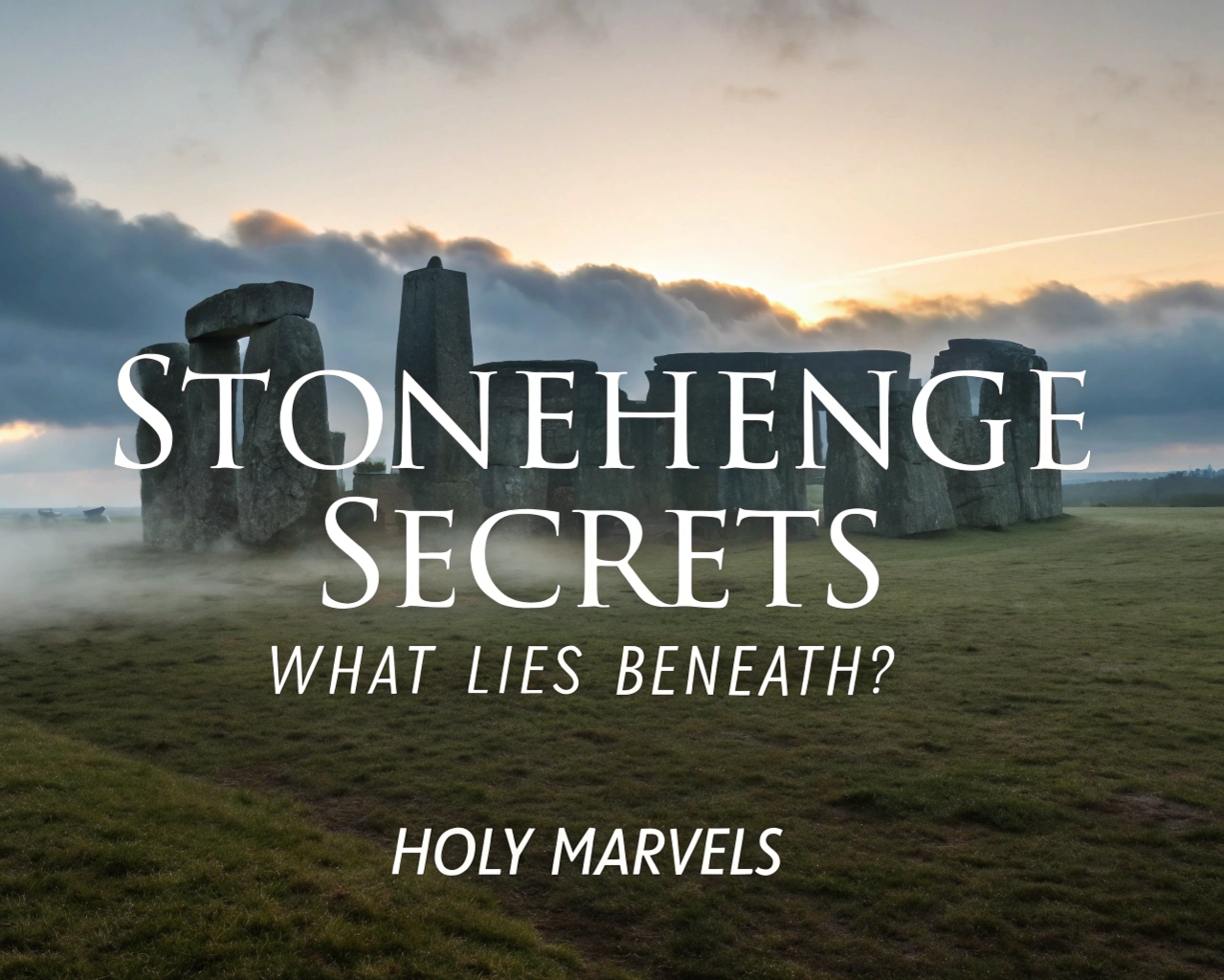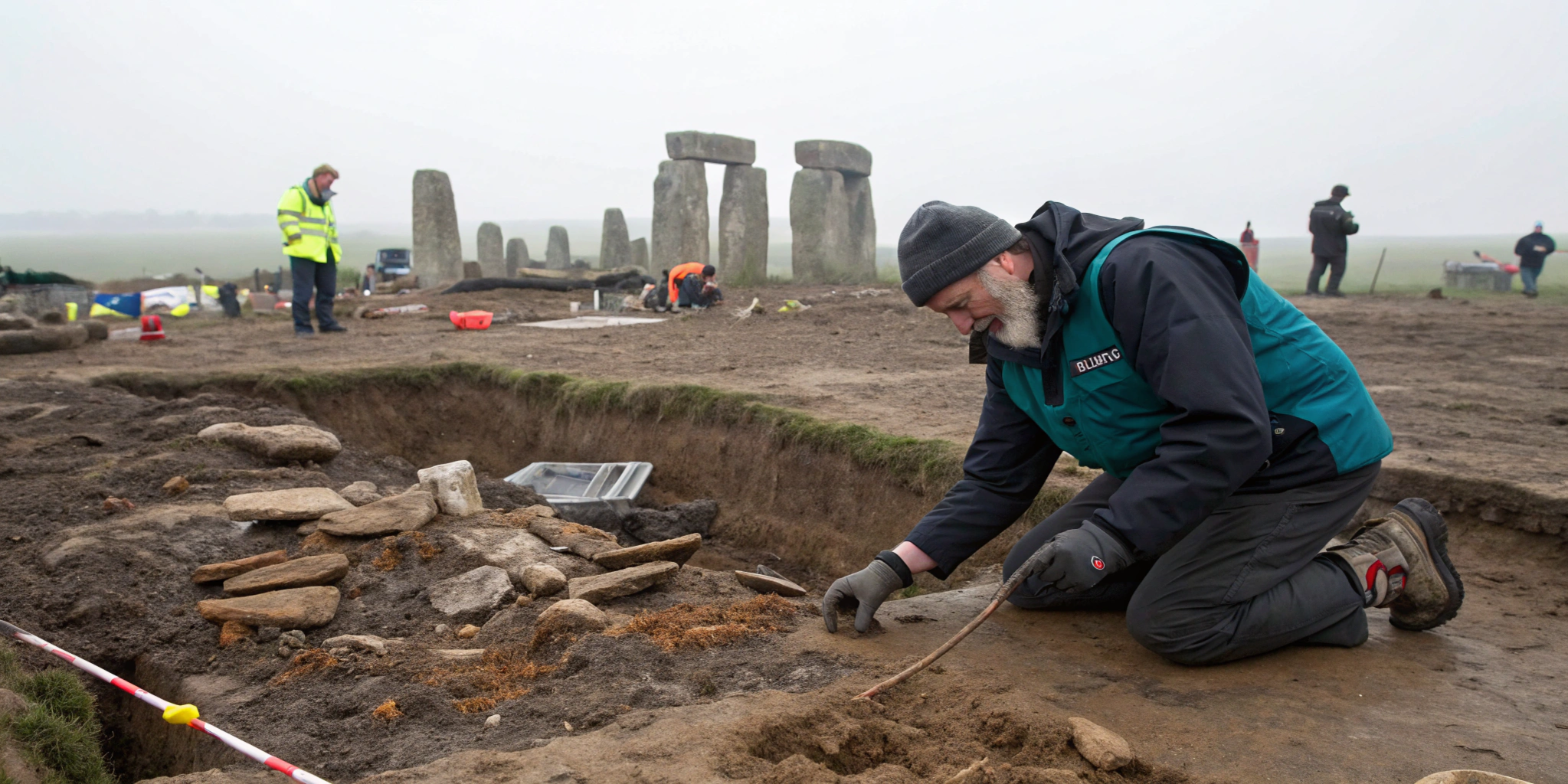Stonehenge Secrets: What Lies Beneath? | Holy Marvels
Salisbury Plain, England, home to one of the world’s most mysterious sights, a circle of towering stones whispering of ancient societies and arcane rites. Known as Stonehenge, this imposing monument has dominated the imagination of archaeologists and visitors for centuries. The name ‘Stonehenge’ is thought to come from the old English or Saxon word ‘stan hengen which means ‘stone hanging because it kind of resembles what gallows looked like in the middle ages—having two uprights with a cross beam. Today, there are 52 stones remaining at the site, laid out in two concentric circles. But scientists think that there were originally about 80 of them. And the stones themselves, massive. They’re 13 feet tall, and some weigh up to 25 tons. In the 1800s, we have a series of archaeologists doing excavations around Stonehenge.
During these digs, they’re finding all sorts of things. Charred wood, bits of antlers, and even Roman pottery. It’s all kind of unremarkable, fueling just one origin theory after another. Then, in 1862, researcher John Lubbock takes a closer look at these various artifacts. Lubbock finds something that, to him, is truly astonishing. Cremated human remains. Now, to a layperson, this might not mean too much. But to Lubbock, this tells him exactly who built Stonehenge. And it is not who anybody expected. According to Lubbock, cremation hasn’t been practiced in this area since the Bronze Age. That means that there was a previously unknown civilization living right here of Bronze Age people. And that’s who built Stonehenge. It’s a major discovery, not just in the history of England, but a huge leap forward in our understanding of Stonehenge.
The Bronze Age in Britain spans from approximately 2500 to 700 BC. It appears that somewhere around 2400 BC, the area around Stonehenge sees the arrival of a group that’s come to be known as the Bell Beaker people. Named for their inverted and highly ornate bell beaker drinking vessels, but the beakers are significant for another advancement. They figured out how to melt tin and copper, alloy mix them together, and to create something new—bronze. Lovett continues to excavate, and sure enough, he finds tools made from bronze. This indicates that Stonehenge was built much earlier than people had previously understood to be built. While we might never know exactly how it was built, experts are determined to figure out why. In the early 1700s, an English scholar makes a groundbreaking observation.
The antiquarian physician Freemason William Stukely discovers that actually, Stonehenge is aligned with the sun. If you stand in the right place, the space between the central megalith perfectly frames the sun’s movement on two days of the year— the summer solstice and the winter solstice. So it seems that Stonehenge is accurately built to highlight the longest and the shortest days of the year. Many scholars speculate that what Stonehenge is—what it seems to be— is a solar calendar, a method of timekeeping. Later researchers have noted that the number of stones corresponds loosely with a 30-day month, and certain stones could mark the start of three 10-day weeks. This is probably the most popular theory on why Stonehenge was built. Visitors still travel to the site to witness the sunrise between the two great stones on each equinox.
The alignment with the sun was almost certainly done on purpose, but that doesn’t mean that it is the purpose, right? Correlation isn’t causation. Just because you paint your house blue doesn’t mean you worship the sky. Despite dozens of investigations, all using the most modern technology, the true purpose of Stonehenge remains a mystery until 2021, when one enterprising archaeologist finally answers a key question about the bluestones. So for at least 400 years, people have known there are two different types of stones at Stonehenge. There’s the sarsen stone, which we know comes from a quarry about 20 miles away. But no one knows where the bluestone comes from. For decades, scientists worked to figure out their origin. First, in 1923, geologist H. H.
Thomas finds a whole bunch of this type of stone, a perfect match, in fact, but where he finds it makes no sense whatsoever. He proposes that the blue stones come from the Preseli Mountains in southwest Wales. It’s a whopping 150 miles away from Stonehenge. Several later archaeologists and geologists continue the work of H. H. Thomas, and eventually modern geochemical analysis proves that he was right. These stones definitely came from Wales. But the exact location is still unknown. Then, in 2021, archaeologist Mike Parker Pearson is able to confirm the exact quarry in Wales that the bluestones came from. That’s when he finds the final missing piece of the puzzle, quite literally. Near this quarry, there are the remains of a dismantled circle of these same bluestones. And like Stonehenge, it’s aligned with the movement of the sun.
And incredibly, Parker Pearson finds a chip of bluestone left behind when it was dismantled. And it fits perfectly into one of the bluestones at Stonehenge. Now we know what happened. This society didn’t just randomly start building at Stonehenge. They migrated there. Many centuries before, they lived in Wales, where they were already making primitive stone circles. And these circles were aligned with the movement of the sun. Parker Pearson determines that this group of people decided to leave the area around 3000 BC. And they dismantle and take their sacred stone circle with them. They then migrate to Salisbury Plain. Once you combine Parker Pearson’s discovery with a few others, suddenly it opens up the idea that there might have been multiple different purposes for Stonehenge throughout the years.
Stonehenge wasn’t just built from scratch the way we see it looking today. It’s a site that has evolved and changed dramatically over the course of 5,000 years. In fact, it doesn’t even start with stones at all. In 1966, Lance and Faith Batcher discover three post holes in the Stonehenge car park that, when analyzed, date back to between 8,500 and 7,000 BC. In this spot, three wooden tree trunks were raised by some early Mesolithic hunter-gatherers. This tells us that a small group of people was beginning to think of this as a sacred place. The site grows in popularity, and other societies start coming to visit. Around 3900 BC, we have evidence of the area being used as this massive meeting place.
Archaeologists have discovered remnants of a feast between a culture of hunter-gatherers and a group of farmers. Now Stonehenge has gone from kind of an outdoor chapel to a great place of multicultural gathering and unity, but there aren’t any stones yet. At least, not for another 900 years. As Mike Parker Pearson discovers, a group of people shows up at around 3000 BC and they bring their stones from Wales with them. The locals welcome these folks with open arms. They say, ‘Please, put your sacred stones right here.’ And they all work together to build a circular earthen enclosure surrounded by a ditch. And in the ditch, they erect 56 posts. And just like they did in Wales, the migrants make sure to align the circle to the sun. Now, Stonehenge is also an astronomical calendar.
As time moves on, Stonehenge also becomes a significant place of burial. As many as 240 burials have been discovered at Stonehenge so far, but there may be more. It makes sense that such a sacred place in life would also be sacred in death. So now it’s a calendar. A holy gathering place, a shared construction project between two cultures, and a cemetery. And around 2500 BC, the locals decide it’s time to give Stonehenge an upgrade. This is when the 80 massive sarsen stones are set up in the familiar circular formation that still captivates visitors today. Researchers think that the end result wasn’t the whole point of Stonehenge. The point was in the process. Stonehenge was like the ultimate community service project, bringing people together, which it’s still doing today.



